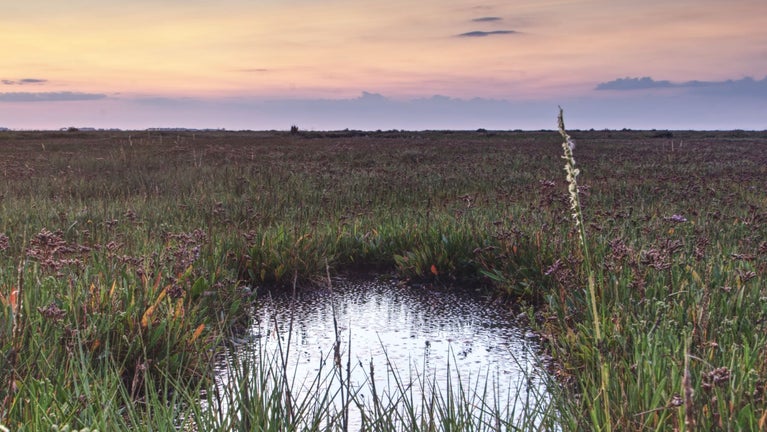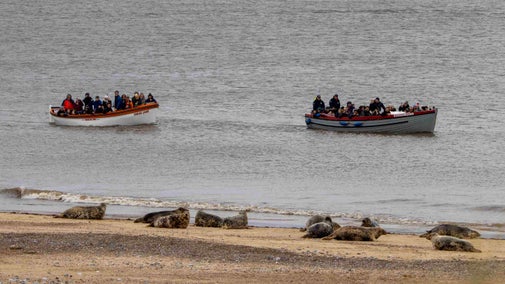
Discover more at Blakeney National Nature Reserve
Find out how to get to Blakeney National Nature Reserve, where to park, things to see and do and more.

Blakeney National Nature Reserve is home to England's largest grey seal colony at Blakeney Point, as well as important wetland habitats and wildlife at Stiffkey Marshes and Blakeney Freshes.
Blakeney Point is home to England's largest grey seal colony with around 9,000 pups born between the end of October and mid-January each year.
The best way to get up close and personal with the wildlife on Blakeney Point is by boat, with one of the seal boat tour operators that are based at Morston Quay. Click here for more information about the seal boat trips.
To prevent disturbance during pupping season, it is not possible to reach the seal colony on foot. Restrictions are in place from late October to early January. Our staff and volunteers, and signs on the beach, will clearly indicate how far along Blakeney Point you can walk.
Duncan Halpin, Norfolk Coast Ranger, explains how Blakeney Point has become home to the UK's largest grey seal colony and what to expect during the pupping season, from end-October to mid-January.
We ask for your permission before anything is loaded, as this content may introduce additional cookies. You may want to read the Google YouTube terms of service and privacy policy before accepting.

To the east of Blakeney village is a small area called Friary Hills. Part of an old friary, the site is a mixture of grassland, trees and gorse and overlooks the Blakeney Freshes. It's family friendly and perfect for a picnic.
Friary Hills is known locally as being a great spot for birdwatching. This part of the coast is the first place that migrating birds flying in from the continent are able to stop and rest.
Head to the top of the Friary Hills, where you'll find a couple of well placed benches. Pause to take in the panoramic views over Blakeney Freshes and beyond to Blakeney Point and harbour.
Comprising approximately 160 hectares of freshwater grazing marsh, Blakeney Freshes is an important area for breeding birds and overwintering wildfowl. For this reason, it's a popular place for birdwatchers.
Some areas are closed for grazing but the National Trail Norfolk Coast Path goes around the perimeter and offers spectacular elevated views.
During the warmer months, Blakeney Freshes is an important area for ground-nesting birds. Species such as lapwing and avocet raise chicks in the surrounding fields.
It's also home to water voles and otters, so be sure to keep an ear out for the tell-tale 'plop' as they drop into the water in the ditches that criss-cross this site.
As the weather turns colder this expansive area becomes the feeding and roosting spot for the thousands of pink-footed and brent geese that migrate to this part of Norfolk.
Whether you're looking for a short meander or a longer stroll, Blakeney Freshes is perfect for a scenic walk. Take a short circular walk to Friary Hills, taking in three different habitats along the way. Or why not take a coastal walk through Blakeney village and around Blakeney Freshes? The 3-mile wheelchair-accessible route is fantastic for spotting wildlife.

Stiffkey Marshes is home to one of the country's richest saltmarshes for wildlife. Flooded daily by the tide it is an important conservation area for breeding birds.
Large flocks of over-wintering geese and waders can be seen during the colder months. Brent and Pink-Footed Geese can both be seen on the saltmarshes, and the skeins of Pink-Footed Geese filling the skies whilst flying in to roost at dusk are an iconic north Norfolk winter sight and sound.
During the warmer months the saltmarsh is a kaleidoscope of colours, with the flowering pink thrift in May and June and the beautiful purple carpet of flowering Sea Lavender in July and August turning into autumnal colours as the weather cools.
The Norfolk Coast Path skirts the saltmarsh towards Blakeney to the east and to Wells-Next-The-Sea to the west, offering amazing walks with breathtaking views and sightings of birds.

Find out how to get to Blakeney National Nature Reserve, where to park, things to see and do and more.
Stiffkey Marshes, part of Blakeney National Nature Reserve, is home to one of the country's richest saltmarshes for wildlife.

Friary Hills and Blakeney Freshes are home to important habitats and diverse wildlife that changes with the seasons.

All you need to know about England's largest grey seal colony and how you can enjoy this remarkable wildlife spectacle on Blakeney Point.
